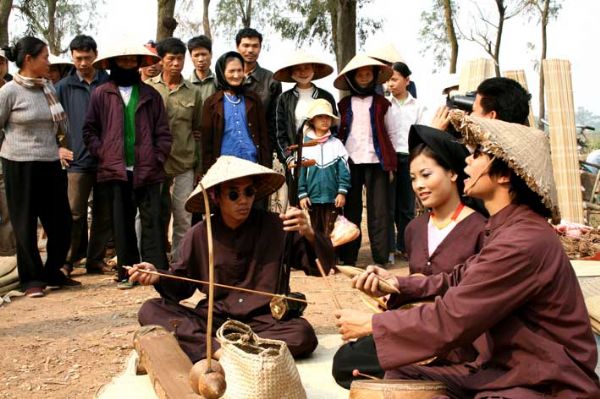|
|

The scene of singing
Xam is staged in Duong
Lam
ancient village,
Ha Tay Province.

The actors and
actresses at
the
Vietnam music
development centre
perform Xam on the
stage in Hanoi’s old
quarter.
| Xam singing is an
art form which has existed for centuries and was very popular in the rural
areas of the northern plains in the past. In the first half of the
20th century, another version of Xam songs appeared in
Hanoi
and was sung by rural people who
came to the city from different provinces to earn their
living.
A folk feature in the heart of the
city
According to a legend which has been
handed down from generation to generation, Xam singing was invented by Tran Quoc Dinh and
Tran Quoc Khanh who were children of King Tran Thanh Tong (1258-1278).
Xam singing
exhibits the optimism and love for life of common blind people who
overcame difficulties and earned their living by singing Xam songs.
In the past, Xam singing was practised during leisure time after
the harvests. The farmers used to invite Xam troupes to their village and their home to
entertain with their repertoire of music. Now, only anbsp;
handful of Xam artists are still alive, such as Ha Thi Cau
in Ninh Binh Province and To Cuc Phuong in Thanh Hoa Province. During the troubled time
of war or when crops were lost, Xam singers could not earn enough
locally to yield a living, so they travelled to many places to sing for a
living. Many of them went to cities, including Hanoi. Crowded
trams, car stations, markets and street corners were the venues for these
entertainers. Gradually, a new style of Xam singing developed on
the basis of the traditional forerunner in rural areas, but it had quick
and ornate rhythms unlike the traditional Xam played in the
countryside, suitable to the busy atmosphere of the city and satisfying
knowledgeable people. It may be said that Hanoi Xam was created at that time.

Singing Xam at a rural market in the
northern
area. | Wandering the 36 streets of Hanoi’s
Old Quarter, Xam singers were accomplished in enriching their songs
with popular poems, particularly those full of folk characteristics by
poet Nguyen Binh, such as “Lo buoc sang ngang” (A Girl’s Anxiety before
Marriage), “Giang sang vuon che” (Moonlight on Tea Garden), “Em di tinh
ve” (A Girl’s Return after a Province Trip), which were loved, put in
writing and popularized by many people. Xam was not only performed
at stations and markets, but also appeared in folk performances,
lullabies, music for funerals, Ca tru (ceremonial songs), etc.
Together with the clanging rhythms of the trams which were once a common
means of transport in Hanoi, Xam
singing became familiar to the city dwellers.
People who revive Hanoi Xam
When tram use discontinued in
Hanoi, so
disappeared the stage for Xam performances. Now only a few people
remember the tunes of Xam of the past.
Musician Thao Giang and researchers
Tran Viet Ngu and Hoang Kieu paid early attention to Xam singing
and were worried about the decline of Xam in Hanoi. With a desire
to revive Xam music, they decided to collect, study and recover the
typical Xam tunes which were popular in Hanoi in the early
20th century. Their records of the singing by old artists were
valuable documents in service of research. They also talked with old
people and sought the specialists’ opinions about Xam. With their
efforts, Xam tune was gradually revived and they agreed to name it
“Hanoi
Xam”. For the first time, Xam tau dien (Xam
performed on trams) was mentioned by specialists.
As the saying goes, “Practice makes
perfect”, the work of the artist and researchers has achieved initial
success. After nearly a year of working, the Xam stage has revived
the former cultural feature of Hanoi. Listening to Xam songs,
people seem to be in a space of Hanoi in the past.
Story by Khuong
Cuong - Photos by
file |